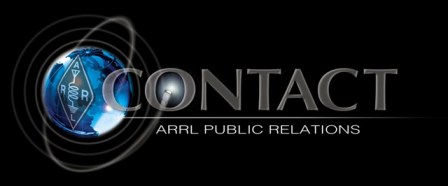October 2014
Vol 12 # 8
In this issue:
Outreach in Hamilton County, Indiana
Nominations for the 2014 ARRL Bill Leonard Award are due by December 5. This is YOUR chance to recognize that reporter in your area who told the story of Amateur Radio to the public in a compelling way. Each recipient — one for audio, one for video, and one for text/print — receives an awards plaque and a $250 donation in their name to the charity of their choosing. Help promote the folks who help promote us.
For those of you who haven’t seen it, FEMA has a wonderful guide on what it takes to be a PIO. “Basic Guidance For Public Information Officers (PIOs)” contains a wealth of information on emergency and disaster response. If you HAVE seen it, take a moment and review it.
ARRL’s Media Hits - Did You Know?
ARRL’s website has a page devoted to Media Hits, listing when Amateur Radio appears in print and video media, blogs, and web journals. Use this resource to gauge how Amateur Radio is being portrayed in the media, and where it’s NOT getting coverage. If it’s not getting coverage, you can change that!
Flip video cameras are hugely popular now. Compact and effective, you can shoot up to 8GB of HD video. That’s a powerful addition to your PIO toolbox. Here’s a video from Cisco Systems (the inventor of the Flip) on how to use their FlipShare software, which comes pre-loaded on every Flip camera.
Outreach In Hamilton County, Indiana
Hats off to the Hamilton County (IN) ARES/RACES for setting up as part of Public Safety Day in Westfield, Indiana’s Village Park Mall on September 6. ARRL Indiana PIC Joe March, KJ9M, reports that during the 6-hour event that highlighted local police, fire rescue and other EMS organizations, “[t]he group demonstrated "off-the-grid" communications using a generator, a local repeater and simplex and IRLP capabilities, answering questions from the public drawn to the parking lot activity from their Saturday shopping.” Way to get out and about! How did your group generate public interest in Amateur Radio during National Preparedness Month? Post your experiences on the ARRL PR Reflector. (Joe March, KJ9M, photo)
Speaking of the ARRL PR Reflector, it’s been quiet as of late. Maybe that’s due to a quiet hurricane season. However, that’s no reason to not share PIO tips, club outreach efforts, or other projects your group is currently involved with. With over 500 members, it’s a great place to ask questions about anything related to being a PIO. Take advantage of the knowledge base of your fellow hams interested in PR outreach. If you’re not subscribed to the ARRL PR Reflector, email me at ARRL HQ and I’ll get you signed up.
I received an e-mail from a person a couple of days ago, asking for help on how to re-establish contact with their local community officials. This person’s radio club provided communications during their local parade for many years, but weren’t contacted this year. I asked, “Did you try contacting them?”
This is why it’s critical to maintain contact with the groups or communities you serve. If you only reach out to your local officials during Field Day to secure your operating site, you’re not going to have the best working relationship. Make sure those groups like your Facebook page or follow your Twitter feed. Or you could always go old-school and call them or meet with them in person. Don’t let those local contacts go stagnant.
This works at our clubs, too. Most Amateur Radio clubs are general-interest clubs, offering a well-rounded introduction to our hobby to the outside world. If your club is general-interest, take a look around the room and see what your different members are doing with their ham radio time. Ask them to make a presentation to the general public about what they do; see if you can get regular monthly or quarterly time at your local library’s auditorium for a regular forum, for example. Our hobby is so diverse, there are dozens of things to choose from to grab the attention of passers-by. I don’t know about you, but in my 32 years of being licensed, I’ve gotten interested in lots of areas of Amateur Radio that I never thought would grab me. But, grab me they did.
It’s important to our hobby’s future that we each make an effort to look at things differently from time to time. We have a history of being experimenters and inventors; that means charting new ground and trying new things. It means embracing change.
When that visitor comes up to our booth or comes to their first club meeting, what we think will get a person interested in our hobby may not be what holds their interest. A good club will have an outreach program that can focus an inquiring stranger on something they will gravitate to. We need to keep this in mind when reaching out to prospective hams: identify who your outreach effort is targeting. There are a lot of sub-groups within “the general public:” young, old, rich, poor, tech-savvy or tech newbies. Listen to what your visitors are telling you they like, and tailor the message to your target audience. Drop me a line if you have questions.
Thanks for all you do.
Sean Kutzko, KX9X
Media and Public Relations Manager
About ARRL >> Media and Public Relations >> Contact Issues >> Contact 2014 >> October 2014






